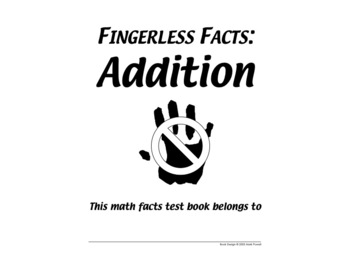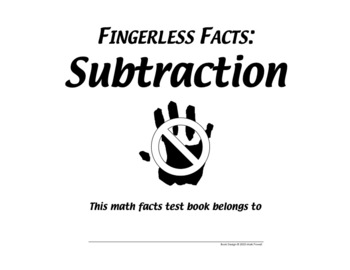Fingerless Facts Memorization Booklets
Mark Powell
16 Followers
Grade Levels
1st - 6th
Subjects
Resource Type
Standards
CCSS3.NBT.A.2
CCSS4.NBT.B.4
CCSS1.OA.B.3
CCSS1.OA.B.4
CCSS1.OA.C.6
Formats Included
- Zip
Pages
32 x 4 booklets
Mark Powell
16 Followers
What educators are saying
Este recurso me encanto fue uno de Los mejores, Les prepare los libritos a los ninos y los pues por dias, para que trabajaron Poco a Poco y resulto aprendienton a multiplicar y divider con la suma y la resta, buen recurso felicidades.
Products in this Bundle (4)
Description
Four booklets, one for each operation, each consisting of 25 memorization tests that progressively increase in difficulty. Headers allow students (or a peer or their teacher) to record date, time started, time stopped, score and accuracy. At the end of each booklet is a table for the student to record their statistics for each test, as well as three charts for recording raw scores, accuracy and speed as bar graphs. Booklets are formatted to be printed on 11x17" paper saddle stapled in the middle so that tests are kept together. These booklets encourage independence and allow progress in math facts memorisation to be viewed over time.
Total Pages
32 x 4 booklets
Answer Key
Does not apply
Teaching Duration
Other
Report this resource to TPT
Reported resources will be reviewed by our team. Report this resource to let us know if this resource violates TPT’s content guidelines.
Standards
to see state-specific standards (only available in the US).
CCSS3.NBT.A.2
Fluently add and subtract within 1000 using strategies and algorithms based on place value, properties of operations, and/or the relationship between addition and subtraction.
CCSS4.NBT.B.4
Fluently add and subtract multi-digit whole numbers using the standard algorithm.
CCSS1.OA.B.3
Apply properties of operations as strategies to add and subtract. If 8 + 3 = 11 is known, then 3 + 8 = 11 is also known. (Commutative property of addition.) To add 2 + 6 + 4, the second two numbers can be added to make a ten, so 2 + 6 + 4 = 2 + 10 = 12. (Associative property of addition.)
CCSS1.OA.B.4
Understand subtraction as an unknown-addend problem. For example, subtract 10 – 8 by finding the number that makes 10 when added to 8.
CCSS1.OA.C.6
Add and subtract within 20, demonstrating fluency for addition and subtraction within 10. Use strategies such as counting on; making ten (e.g., 8 + 6 = 8 + 2 + 4 = 10 + 4 = 14); decomposing a number leading to a ten (e.g., 13 - 4 = 13 - 3 - 1 = 10 - 1 = 9); using the relationship between addition and subtraction (e.g., knowing that 8 + 4 = 12, one knows 12 - 8 = 4); and creating equivalent but easier or known sums (e.g., adding 6 + 7 by creating the known equivalent 6 + 6 + 1 = 12 + 1 = 13).





